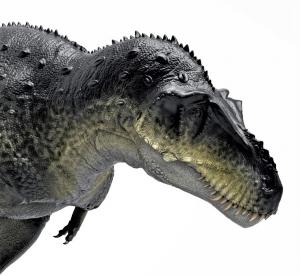The Creature that Terrified T-REX…and FED On it.
Paleo-Author Max Hawthorne shows how Tyrannosaurus rex used specialized sensors to keep from ending up on the menu.
BUCKINGHAM, PA, US, February 19, 2019 /EINPresswire.com/ -- Max Hawthorne, author of the bestselling Kronos Rising novel series and a passionate rock-hound, may have explained a scientific oddity that has fueled the imagination of both paleontologists and the public of late: the mystery of pit-like organs known as foramina that adorned the muzzles of T-rex and other theropod dinosaurs. “These pinhead-sized pits are similar to the pressure sensors lining the faces of alligators and crocodiles” Hawthorne said during a recent statement. “They’re like tiny sonar arrays: so sensitive, the animal can hunt underwater in complete darkness. But why would a terrestrial predator like Tyrannosaurus have them?”“There have been theories bandied about that these sensory pits helped make Tyrannosaurs passionate lovers that relished foreplay. I call them the ‘Cads of the Cretaceous',” Hawthorne said with a grin. “But in reality, the foramina likely served a far less romantic and more utilitarian purpose: to prevent the animal from being eaten.”
When asked what kind of predator could take down a Tyrannosaurus, Hawthorne’s answer came easily. “Why, a primeval crocodile, of course,” he said. He went on to demonstrate how, courtesy of the research he does for his novels, he’s earned the nickname, 'Prince of Paleo-Fiction'. “There have been crocodiles around since the Jurassic. And before them, during the Triassic, there was an array of crocodile-like predators called Phytosaurs. Some of them grew up to 12 meters, rivaling such infamous dinosaur killers as Deinosuchus and Sarcosuchus. The point is, ever since there were dinosaurs there have been things lurking in the water that could feed on them – including seemingly invincible predators like T-rex.”
“And that is why foramina came in handy,” Hawthorne explained. “When a Tyrannosaur waded into the water and lowered its head to drink, much like one of today’s flightless birds, the Cassowary, it was vulnerable. However, with its muzzle lined with pressure sensors like the ones on another famous dinosaur, the fish-eating Spinosaurus, T-rex could often sense an approaching crocodylomorph moving in for the kill and had a split-second’s warning to rear back – hopefully avoiding the strike.”
Hawthorne revealed another discovery his research has unearthed. “It turns out these sensory pits weren’t exclusive to Tyrannosaurs. Virtually all extinct theropods had foramina to some degree, which makes perfect sense. Allosaurus, Ceratosaurus, Carcharodontosaurus…even Deinonychus, the inspiration for the ferocious “raptors” in Jurassic World. They all needed to drink, and crocodiles were everywhere.”
Hawthorne also pointed out an interesting analogy between some of the top terrestrial predators of today, i.e. lions and tigers, and extinct theropods like T-rex. “Extant big cats face the same threats from crocodiles today that dinosaurs did then, only on a smaller scale,” he said. “Instead of water-sensitive sensor pits, they’ve evolved whiskers to do the job. A cat’s whiskers can detect minute pressure changes in the air, including the kind the surface of a pond generates as something big moves beneath it. If you ever watch a lion or tiger drink,” he continued, “Their senses are locked onto the water. They know there’s something out there, they just don’t know if it’s preparing to strike.”
When asked what he thought a T-rex’s chances would be if grabbed by a similar-sized crocodile, Hawthorne shook his head. “Tyrannosaurs were fearsome predators, but they were bipedal and needed to stay on their feet in order to best deliver that amazing bite. If one was pulled off its feet and dragged into the water, it would be hard-pressed to defend itself. And, let’s not forget, crocodiles usually aren’t alone. Think of an African lion pulled under and attacked by a half-dozen Nile crocs; it wouldn’t be pretty.”
Kevin Sasaki
Media Representative
+1 310-650-3533
email us here
Legal Disclaimer:
EIN Presswire provides this news content "as is" without warranty of any kind. We do not accept any responsibility or liability for the accuracy, content, images, videos, licenses, completeness, legality, or reliability of the information contained in this article. If you have any complaints or copyright issues related to this article, kindly contact the author above.

